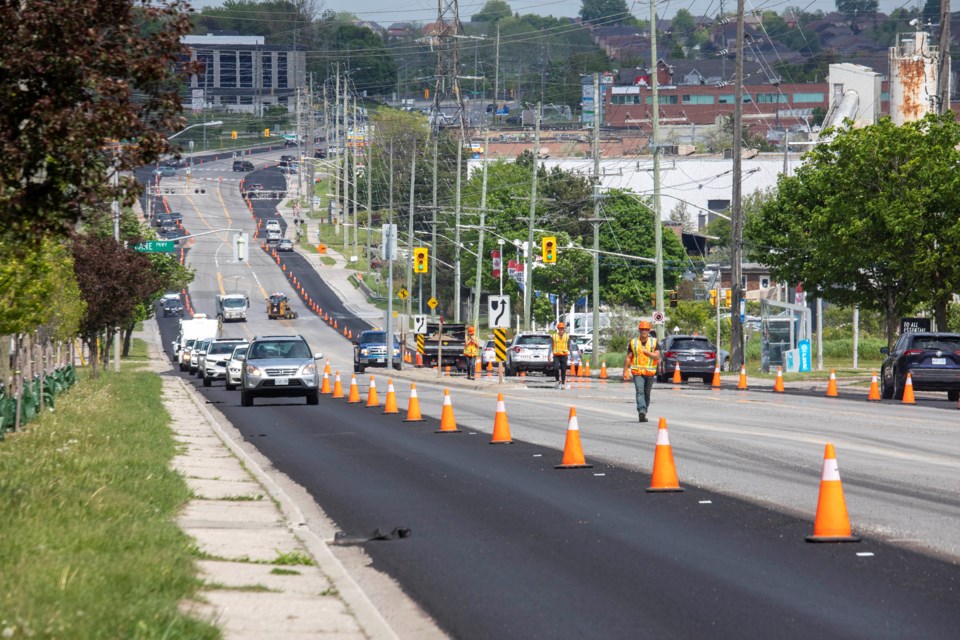To say that Newmarket drivers reacted with disdain to the news that rolling lane closures on Mulock Drive and Davis Drive will be a fixture this summer is an understatement.
But as a Newmarket resident himself and York Region’s capital planning and delivery director for transportation services, it’s a view Salim Alibhai hears often.
“My own wife was driving on Mulock this morning (Monday) and she called me to ask what’s happening on Mulock, how come it’s down to one lane,” Alibhai said with a laugh. “I hear it from my own family.”
The good news is that only one of the region’s main east-west roadways through Newmarket will undergo a preventive maintenance treatment known as microsurfacing at a time, Alibhai said.
Microsurfacing is an interim measure that coats a road with a mixture of liquid asphalt and small stones around the five-year mark since paving to extend the life of the road beyond an anticipated 20 years, Alibhai said.
Mulock was last paved in 2014, and Davis Drive in 2015 although, admittedly, the latter might feel like yesterday to drivers who navigated the lane closures and construction of the Viva rapidway that was completed five years ago.
And, the section of Davis from Huron Heights up to Hwy. 404 was last paved in 2009.
Alibhai acknowledges that some residents may wonder why road crews are back again so soon.
“It is for our benefit, it’s short-term pain,” he said. “It’s similar to what we do to maintain our homes and vehicles, like oil changes. Road surfaces get beat up with the sun, air and water, and traffic takes a toll and roads degrade over time. So, every few years we come back and do some work and that extends the life of the road.”
The roadwork on Mulock began mid-May with curb and storm basin repairs and now, until about mid-July, temporary lane restrictions can be expected Mondays to Saturdays from 7 a.m. to 7 p.m. near the section of road where crews are working.
Both roads will be treated from Yonge to Hwy. 404, and one lane in each direction will be open around that particular day’s work site.
“It’s the perfect time to do the work on Mulock and on Davis since traffic is down because of the COVID situation,” said Alibhai.
Two Mulock intersections are not included in this summer’s work, including at Leslie street, which was paved a few years ago when it was widened from Mulock to St. John’s Sideroad, and at Bayview Avenue, which is too far gone to benefit from microsurfacing, Alibhai said. Bayview will be addressed at a later date.
Once Mulock and Davis are completed, the latter expected to be mid-August, drivers will notice a slightly rougher surface. This allows for better surface traction when braking.
“The roads will get two coats of microsurfacing and then be painted, and August is the end of the entire project for both roads,” said Alibhai.
“This is a fast-moving project and there’s no excavating or grinding the existing road,” he added. “After this, we should be good to go for another five or six years before another treatment.”
Fast facts for 2020:
- $404 million will be invested in roads and transit infrastructure programs for growth and asset management with construction planned at over 80 locations across the York Region.
- With an investment of $277 million in the growth program, construction will continue on 11 major capital infrastructure projects and work will commence on 10 new projects.
- Under the asset management program, $127 million will be invested in roads and transit infrastructure and fleet. Construction is planned at more than 60 locations throughout the region to keep road and transit assets in a state of good repair
- On average, it takes eight to 10 years to deliver major capital infrastructure projects. Before construction can commence, environmental assessment studies need to be undertaken, projects designed, permits and approvals/agreements from regulatory authorities obtained, property acquired and utilities relocated.
- Pre-construction work on 29 growth projects is being undertaken in 2020, including a project to widen Yonge Street from Davis Drive to Green Lane.
The Regional Municipality of York maintains more than 50 regional roads throughout the region.
For more information, visit here.


